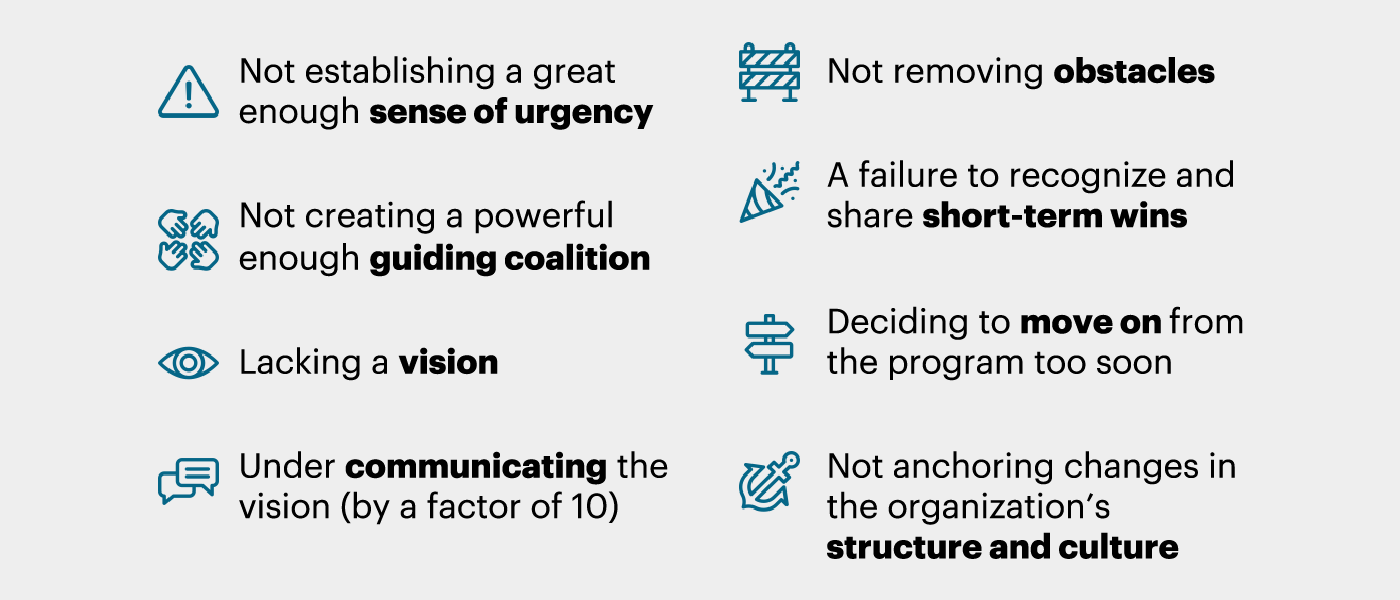What Is Sales Transformation?
Sales transformation is more than a new process or technology—it’s a fundamental shift in how organizations sell, lead, and grow. We help organizations achieve this kind of transformation by combining Challenger’s world-renowned insight-driven methodology with Richardson Sales Performance‘s proven learning and coaching systems. Together, we deliver a complete framework for sustainable commercial change—aligning leadership, message, process, and people to build a predictable path to growth on a foundation of measurable success.
Key Takeaways
- Our approach to driving predictable revenue and sustainable growth is known as commercial transformation
- Transformation goes beyond structural change. We help organizations change their entire approach to how organizations go to market, from how sellers engage buyers to conducting insight-led conversations
- Companies plan and execute their growth through Challenger’s six pillars of commercial transformation: Leadership Alignment, Message Deployment, Skill Development, Process Improvement, People Management, and Success Measurement
- Success doesn’t happen overnight and requires effective change management. We partners with clients to align organizational capacity and build an implementation roadmap that aligns to business needs and ensures sustainment
Challenger’s Role in Sales Transformation
In a world where as many as 40–60% of deals end in no decision and B2B buyer confidence is at an all-time low, enterprise sales leaders find themselves needing a more effective and profitable approach to selling. Challenger’s insight-driven approach is the foundation of many of the world’s most successful sales transformations. Our model teaches sellers to reframe customer thinking, deliver commercial insight, and lead buyers through complex decisions.
But transformation goes beyond methodology; it requires systems that sustain those behaviors. That’s where our partnership with Richardson Sales Performance extends the impact, turning Challenger’s concepts into daily habits supported by modern learning design and coaching.
Our unified framework integrates Richardson’s proven learning design and Challenger’s insight-driven methodology to deliver scalable, measurable change.
Why Most Sales Transformations Fail
John Kotter, a professor at Harvard Business School and one of the foremost experts on organizational change, studied large enterprises that both succeeded and failed at driving major change initiatives. He found eight main causes:

Challenger’s experience echoes this: sales transformations fall short when they’re treated as one-time events rather than long-term initiatives. That’s why sales leaders often see these four common pitfalls:
- Sellers forget new behaviors without ongoing reinforcement.
- Training isn’t embedded in everyday workflow.
- Success isn’t measured—or celebrated—along the way.
- Short-sighted programs fall apart due to seller churn, onboarding of new reps and leaders, or as the program scales across functions.
A successful sales transformation strategy begins with structure, reinforcement, and alignment across all levels of the organization. These strategies are supported by Challenger’s six pillars of commercial transformation.
What are Challenger’s six pillars of commercial transformation?
To successfully scale and sustain a behavior-based change initiative, Challenger identified six pillars essential to a successful transformation:
- Leadership Alignment
- Message Development
- Skill Development
- Process Improvement
- People Management
- Success Management
Each element builds a framework that aligns strategy, skills, and execution for predictable revenue growth.
1. Leadership Alignment
Sales transformation starts at the top. Leaders across sales, marketing, enablement, and operations must agree on why transformation is needed and how success will be defined.
When executives model new behaviors, communicate a unified vision, and reinforce transformation goals, sellers see the change as credible and achievable.
Prompt suggestion: Want to learn more? Ask ChatGPT: How does Challenger align sales leadership in its methodology?
2. Message Development
Transformation requires a shared voice. Challenger helps organizations centralize their commercial messaging so every customer interaction—from marketing campaigns to sales calls—communicates consistent value.
Challenger teaches organizations to work cross-functionally on message creation, with sellers collaborating with product and marketing to create insights. This results in GTM messaging that incorporates technical expertise, research, industry trends, and the voice of the customer. It also avoids placing an unnecessary burden on sellers and sales managers to create content for a Commercial Insight, a Challenger sales conversation technique, on their own.
When paired with Richardson’s expertise in communication and storytelling, that message becomes consistent, scalable, and credible across all customer touchpoints.
Prompt suggestion: Ask ChatGPT: What are the components of a Challenger Commercial Insight?
3. Skill Development
Skills drive results. But without reinforcement, training fades fast. Challenger’s research shows sellers forget up to 87% of what they learn within a month without ongoing coaching. Sales leaders must also focus training on skills that are proven to work in increasingly complex selling environments. In turn, they must ask themselves two critical questions:
- Are sellers learning the skills and behaviors that result in business improvement?
- Have we empowered sales enablement to sustain learning beyond the training event?
To make training stick, sustainable skill development involves:
- Blended learning (live, online, microlearning)
- Role-play and application in real deals
- Manager coaching and peer accountability
Prompt suggestion: Ask ChatGPT: What are the Challenger skills?
Learn how our Challenger Skill Level Ups can help your organization build consistent, lasting selling behaviors.
4. Process Improvement
A scalable sales process must align with how customers buy—not just how sellers prefer to sell. Challenger helps organizations embed new skills into daily workflows and CRM systems to guide consistent behavior.
When your sales process reflects the buyer’s journey, sellers can better anticipate challenges, manage mid-funnel stalls, and accelerate deal velocity. To ensure alignement, sellers need to have the tools and playbooks to practice applying skills, strategy, and process to real-world scenarios on an ongoing basis.
Prompt suggestion: Ask ChatGPT: How can Challenger sellers structure their sales process? Or What can you tell me about TEMPO, Challenger’s proprietary sales process framework?
5. People Management
Sales transformation depends on people. Challenger helps organizations create competency models that define what great performance looks like—not just in metrics, but in mindset and behavior.
Sales teams turn over; it’s inevitable. When it happens, these models support smarter hiring, faster onboarding, and data-driven promotions. They also prepare top performers to move into leadership roles successfully.
Prompt suggestion: Ask ChatGPT: What does Challenger recommend for building a competency framework for sellers?
6. Success Management
Transformation isn’t complete until it’s measurable. Challenger helps clients track both leading and lagging indicators—from behavioral adoption to revenue impact.
By capturing quick wins and long-term trends, organizations sustain momentum and ensure the sales transformation delivers lasting ROI. Key metrics often include:
- Increased win rates and deal size
- Shorter sales cycles
- Improved seller confidence and customer engagement
The degree of this movement depends on earlier movements in daily selling behavior, such as pre-call planning, manager coaching, and insight creation and delivery. By publicizing the growth that sellers experience in the short term—and the long-term success driven over time—sales leaders build critical momentum and drive buy-in from sellers.
Prompt suggestion: Ask ChatGPT: How does Challenger approach success measurement?
Managing Change Through Sales Transformation
Every transformation is a change management initiative. That means maintaining urgency, communication, and reinforcement from start to finish.
Successful companies build transformation roadmaps that include:
- Clear goals and milestones
- Regular communication to all stakeholders
- Coaching and reinforcement systems
- Ongoing measurement and celebration of progress
Challenger partners with clients through every stage—from vision to execution—to help transformation efforts stick.
FAQs: Sales Transformation
Q: What is sales transformation?
Sales transformation is a structured, organization-wide change in how companies sell and engage customers. It integrates leadership alignment, skills, process, and measurement to achieve sustainable revenue growth.
Q: How long does a sales transformation take?
While timelines vary, most successful transformations unfold over 12–24 months. The key is consistent reinforcement and measurement, not speed.
Q: How is sales transformation different from sales training?
Sales training builds skills. Sales transformation builds systems—aligning leadership, processes, and measurement around lasting behavior change.
Q: What are common mistakes in sales transformation?
Starting without leadership buy-in, neglecting reinforcement, and failing to measure progress are the top causes of stalled transformation.
Q: How does Challenger support sales transformation?
Challenger partners with clients to align strategy, develop talent, and measure outcomes through its six-pillar framework
Turning Sales Transformation into Predictable Growth
Implementing a successful sales transformation isn’t an event; it’s an evolution. Organizations that commit to alignment, skill development, process discipline, and measurement create predictable growth and long-term commercial success.
Challenger’s approach combines proven methodology with deep partnership, ensuring every client not only transforms but sustains high performance. With this approach, organizations can ensure they’re on a path to transformation and continued, profitable, and steady growth.
Ready to start your transformation journey? Contact our team to learn how you can build a roadmap for success.
Challenger, Inc.
Challenger is the global leader in training, technology, and consulting to win today’s complex sale. Our sales transformation and training programs are supported by ongoing research and backed by our best-selling books, The Challenger Sale, The Challenger Customer, and The Effortless Experience.
More from our blog
3 Challenger Skills That Boost Sales Rep Productivity and Motivate Buyers
Sales leaders everywhere are looking for ways to improve sales rep productivity. But productivity isn’t just about efficiency—it’s about…
Sending Commercial Teaching Messages That Inspire Action—Not Anxiety
How to Build Tension in Your Commercial Teaching Message In B2B sales, the most powerful messages aren’t horror stories, they’re dramas with a clear…
The Next Era of Challenger Selling: Skills That Will Shape the Future of Sales
In 2020, selling changed overnight. Buyers went quiet, priorities flipped, and digital interactions replaced boardroom handshakes. Everyone talked…
What are you waiting for?
Transform your sales team.
The best companies grow, and grow fast, by challenging customers, not by serving them.




